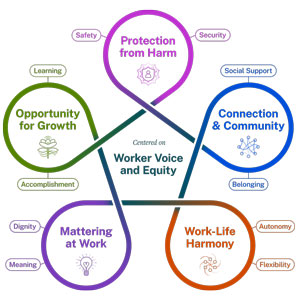
Illustration: HHS.gov
In October, in an effort to help businesses of all sizes develop and update their policies, processes and practices that support the mental health and well-being of their workers, U.S. Surgeon General Dr. Vivek Murthy released the “Surgeon General’s Framework for Mental Health and Well-Being in the Workplace.”
The 30-page document is designed to be the foundation on which businesses can build a plan that will help its employees. The Framework features Five Essentials that business leaders can follow to support their teams’ mental health and well-being. The Framework can be downloaded, along with a graphic that spells out the Five Essentials and a deck of questions to help employers get started, at HHS.gov/surgeongeneral/priorities/workplace-well-being/index.html.
HELPING WORKERS
The Framework was developed to help the American public better understand and address factors that affect public health. “It will require organizations to rethink how they protect workers from harm, foster a sense of connection among workers, show workers that they matter, make space for their lives outside work, and support their growth,” Dr. Murthy said. “It will be worth it, because the benefits will accrue for workers and organizations alike.”
According to the U.S. Department of Health and Human Services (HHS), the average full-time worker in the U.S. spends about half of their waking life at work, so workplaces play a significant role in shaping workers’ mental and physical well-being. Recent surveys illustrate the toll COVID-19 has taken on workers, according to the HHS. A 2021 Mind Share Partners’ survey, for example, shows 76 percent of workers nationwide reported at least one symptom of a mental health condition, such as anxiety and depression. This is a 17 percent increase over 2019. In addition, 84 percent of respondents to a 2022 American Psychological Association survey said at least one factor in their workplace had a negative impact on their mental health.
IMPLEMENTING AN ACTION PLAN
In light of the high number of workers who have left their jobs over the past two years, businesses can take steps to help strengthen the well-being of their workers.
The Framework’s Five Essentials are as follows:
1. Protection from Harm. Creating the conditions for physical and psychological safety is a critical foundation for ensuring mental health and well-being in the workplace. To promote practices that better assure protection from harm, workplaces can:
- Prioritize workplace physical and psychological safety.
- Enable adequate rest.
- Normalize and support focusing on mental health.
- Operationalize diversity, equity, inclusion and accessibility (DEIA) norms, policies and programs.
2. Connection and Community. Fostering positive social interaction and relationships in the workplace supports worker well-being. To promote practices that better assure connection and community, workplaces can:
- Create cultures of inclusion and belonging.
- Cultivate trusted relationships.
- Foster collaboration and teamwork.
3. Work-Life Harmony. Professional and personal roles can create work and non-work conflicts. To promote practices that better assure work-life harmony, workplaces can:
- Provide more autonomy over how work is done.
- Make schedules as flexible and predictable as possible.
- Increase access to paid leave.
- Respect boundaries between work and non-work time.
4. Mattering at Work. People want to know that they matter to those around them and that their work matters. Knowing you matter has been shown to lower stress, while feeling like you do not can increase the risk for depression. To better assure a culture of mattering at work, workplaces can:
- Provide a living wage.
- Engage workers in workplace decisions.
- Build a culture of gratitude and recognition.
- Connect individual work with organizational mission.
5. Opportunities for Growth. When organizations create more opportunities for workers to accomplish goals based on their skills and growth, workers become more optimistic about their abilities and more enthusiastic about contributing to the organization. To promote practices that better assure opportunities for growth, workplaces can:
- Offer quality training, education and mentoring.
- Foster clear, equitable pathways for career advancement.
- Ensure relevant, reciprocal feedback.
“A healthy workforce is the foundation for thriving organizations and healthier communities,” Dr. Murthy said. “As we recover from the worst of the pandemic, we have an opportunity and the power to make workplaces engines for mental health and well-being, and this Framework shows us how we can start.”
Leave A Comment